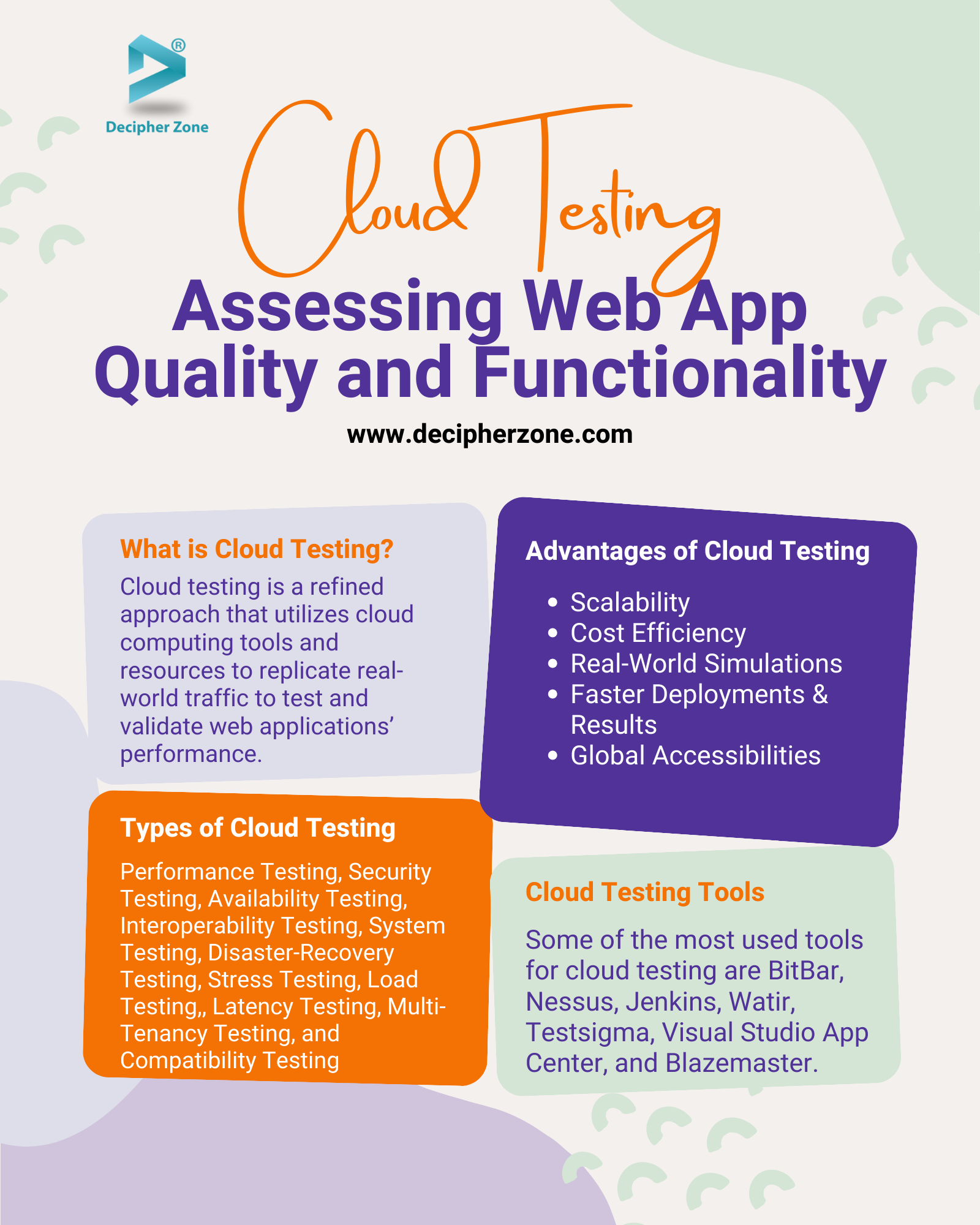Ensuring web applications’ reliability, quality, functionality, and performance has become crucial in today’s fast-paced technological world. The most effective and efficient method to achieve this is through cloud testing.
Cloud testing has emerged as a popular choice for businesses due to its cost-effectiveness, speed, and low maintenance requirements. Unlike traditional testing methods where software is installed on local servers, cloud testing can be easily leased from a service provider. It offers the flexibility to scale services up and down based on specific business requirements, making it an ideal choice for businesses of all sizes.
In this article, we will explore the various aspects of cloud testing in detail. We will discuss the importance of cloud testing, its benefits, and best practices.
What is Cloud Testing, and Why is it Important?
Cloud testing is a refined approach that utilizes cloud computing tools and resources to replicate real-world traffic to test and validate web applications’ performance. In simpler terms, cloud testing defines a testing method that harnesses cloud computing environments to imitate real-world user interactions and traffic of web apps.
This encompasses executing tests across a spectrum of devices and platforms while rigorously assessing scalability, performance, and security.
This innovative approach to testing enables developers to analyze web apps in authentic, real-world environments without the obligation to invest in expensive hardware and infrastructure.
Needless to say, cloud testing has become an indispensable facet of software testing that offers flexibility to efficiently adjust the scale of testing environments based on the project requirements. This flexibility further simplifies web app testing in diverse scenarios and user loads, securing a comprehensive application capabilities evaluation.
Not just that, cloud testing also provides seamless collaboration between teams to allow immediate test results sharing. This seamless result exchange accelerates error resolution, contributing to an elevated quality of the web application. In essence, cloud testing has redefined the landscape of software testing, making it not just a tool but a strategic asset in delivering robust and high-performance web applications.
Advantages of Cloud Testing
Some of the major advantages of cloud-based web application testing over conventional tools for test automation are as follows:
Scalability
Scalability in the traditional testing landscape often poses challenges for developers. However, with cloud testing, they gain access to limitless resources virtually, ensuring that the web app is tested under various loads and provides a better understanding of its performance.
Cost-Efficiency
When a business invests in cloud computing for testing, tools and other resources come at a pocket-friendly rate as they only pay for what they use compared to conventional testing tools with renewable licenses. This financial flexibility allows businesses to do resource allocation sensibly, optimizing testing processes without burning a hole in their pocket.
Real-World Simulations
The value of a web app lies in its real-world usability. Therefore, cloud testing simulates real-world user scenarios to identify potential vulnerabilities, threats, bottlenecks, and performance issues. With real-world simulations, the web app experiences stringent testing that ensures its resilience in the face of different usage patterns.
Faster Deployment and Results
By accelerating the testing process, cloud testing allows swift test case deployment and produces results in real time. This agility improves the development cycle and allows quick fixes based on the results.
Global Accessibility
With cloud testing, collaboration knows no boundaries. The testing team can access the testing environment from anywhere around the world, enhancing team collaboration and overall testing efficiency.
Types of Cloud Testing
With cloud testing environments, you can perform a wide range of functional and non-functional web app testing. Some types of cloud testing that can be conducted include:
-
Performance Testing: Evaluates how a system is performing with respect to stability and responsiveness under a given workload.
-
Security Testing: Identifies security vulnerabilities in the code and data of the web application.
-
Availability Testing: Assess whether the web application is able to meet the required service-level agreement (SLA) to ensure its operability during peak load time and quick recovery from unexpected failures.
-
Interoperability Testing: Validates whether web app performance is affected by infrastructure changes.
-
System Testing: Examine web app features to confirm they are working as expected.
-
Disaster Recovery Testing: Analyze if the cloud downtime or other unpredictable scenarios will not lead to any permanent damage like failed backups, data loss, and network interruptions.
-
Stress Testing: Determines performance issues and bottlenecks and resolves them before they cause a wreck in the web app.
-
Load Testing: Evaluates that the web app’s performance remains optimal even in the high user traffic.
Read More: What is Cyber Resilience: Components, Benefits, and Threats
-
Latency Testing: Tests whether a web application responds to actions quickly.
-
Multi-Tenancy Testing: Tests the web app's performance and functionality with multiple tenants simultaneously accessing it.
-
Compatibility Testing: Determines the compatibility of the web app across different browsers and operating systems.
Read More: How to Improve Security in Web Application Development?

Best Practices Before Choosing a Cloud Testing Service Provider
Some of the key best practices to consider when opting for a cloud testing platform are:
-
Conduct thorough research about the cloud-based testing tools before choosing one for your specific requirements.
-
The ideal cloud testing platform must have consistent tech support, a high-security level, and minimal wait time for queued tests.
Read More: Securing Coding Practices Every Developer Should Know
-
Check the range of services that the cloud solution provider is offering. Ensure it includes testing tools, physical infrastructure, licenses, and thorough apparatus.
-
Evaluate the compliance certificate of the cloud provider to ensure the security of the web app’s data.
-
Additionally, the cloud testing platform should enable team-wide testing and assist QA managers in tracking their projects.
Conclusion
Cloud testing enables businesses to identify the issues in the web application without breaking their banks with physical infrastructure costs. Most organizations are now adopting cloud-based testing solutions due to their scalability, cost-efficiency, global accessibility, and flexibility.
Evidently, with a continuous increase in the use of cloud-based solutions, cloud testing has a bright future ahead. So, if you are seeking to develop and test your web app using cloud computing services, get in touch with our experts, share your requirements, and get a customized quote to hire a development team now!
FAQs: Cloud Testing: A Guide to Assessing Web App Quality and Functionality
What is the future of cloud testing?
The continuously increasing demand for cloud-based applications will also boost the need for cloud testing to ensure their security, performance, and reliability.
Other than that, the use of machine learning and artificial intelligence will also become widespread in cloud testing. Overall, with new tools and technologies being developed to meet user and business demands alike, the future of cloud testing seems promising.
Which tools are used for cloud testing?
Some of the most used tools for cloud testing are BitBar, Nessus, Jenkins, Watir, Testsigma, Visual Studio App Center, and Blazemaster.
How is cloud testing different from traditional testing?
While traditional testing involves testing applications on local infrastructure through installed resources and tools, cloud testing uses virtual test environments to run different testing on applications more precisely at a much cheaper cost.

